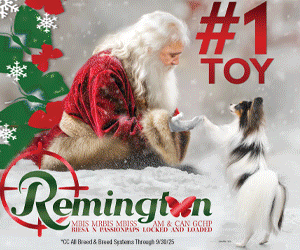A New Emphasis On Junior Showmanship
To read the complete article click here 282 – September, 2012
By William Given
In the July issue we looked at how very important juniors are to the future, even the continued existence, of the sport of purebred dogs. I addressed the need we have to actively recruit juniors and where we might be able to find the young people who would likely enjoy showing dogs. I addressed our obligation to provide our youth with the education and encouragement necessary to make dog showing both a positive experience and personally rewarding. I also touched on our need to help these young people find a suitable dog and provide them with support at the shows.
Now, let us look at a few more things we can do individually, as clubs and through the AKC to demonstrate support for Junior Showmanship and make things more fun and rewarding for our young people. After all, the effort spent recruiting young people will be for naught if we do not make the same concerted effort to retain them.
ESTABLISH A JUNIOR SHOWMANSHIP PROGRAM
I call on all Specialty, Group, All-Breed and National Breed Clubs to establish a Junior Showmanship Program. If your club already has a Junior Showmanship Program, look for ways to expand it and make it more effective. A quality Junior Showmanship Program demonstrates your club’s support of the American Kennel Club’s objectives and encourages junior handlers to maintain their enthusiastic interest in the sport of purebred dogs. The following are some basic components of a good program that I believe will lead to success.
DESIGNATE A JUNIOR PROGRAM COORDINATOR
The selection of a club member to serve as the Juniors Liaison seems a reasonable first step. The Juniors Liaison serves as the club’s point of contact to answer questions and offer advice to juniors and their parents who are currently involved in the sport, or want to participate in Junior Showmanship and have little idea where to begin.
BUILD A JUNIORS WEB PAGE
Create a Juniors Web Page on your club’s website specifically dedicated to juniors. Here you can inform juniors of the club’s activities and invite their participation. It is the perfect spot to recognize the juniors winning and placing in the Junior Showmanship competition at your shows and matches. It is a great place to say thank you publicly to the juniors who volunteer to steward or serve on the show committee. We should also seize the opportunity to acknowledge juniors for their academic achievements in school and their volunteer work in the community. Remember, our young people are on their computers all the time so the page will need to be kept up-to-date. If you start it and call it good, everyone will know the club’s support for Junior Showmanship really isn’t there.
JUNIOR SHOWMANSHIP SCHOLARSHIPS
A good many kennel clubs offer scholarships, and that is how it should be. However, the lion’s share of those scholarships are going to veterinary medicine students. Club scholarships that are being awarded to high school seniors are often reserved for students who have indicated they will be majoring in animal sciences. Both are okay. If clubs have the financial resources, it is only right that they do this.
I would like to recommend that all Specialty, Group, All-Breed, and National Breed clubs consider offering Junior Showmanship Scholarships if they do not do so already. These scholarships do not have to be large and can reasonably be based on the club’s financial resources. It should not matter if the juniors intend to go to school in state or out of state or if their major will be art or botany, accounting or zoology. These scholarships represent a club’s fiscal commitment to Junior Showmanship and the future of our sport.
The members and leadership of clubs can set whatever criteria they choose. For example: The applicant shall have participated in Junior Showmanship for at least one full year, the applicant must have a high school grade point average of 3.0 at the time of matriculation, the applicant must submit a 200-500 word essay on How Participation In Junior Showmanship Has Affected My Life. Clubs can give preference to applicants who have volunteered at local municipal animal shelters or rescue groups, have worked for the club as a ring steward or in some other capacity. Preference can be given to the children or grandchildren of club members or to applicants residing in the club’s geographical territory. The goal is simply to acknowledge the young person’s participation in Junior Showmanship and help them with the ever-increasing costs of higher education.
INCENTIVES, GRANTS AND STIPENDS
Some National Breed Clubs have incentive programs for juniors. The Labrador Retriever Club, for example, established a $500 grant to be awarded to any Junior Handler who has qualified for the AKC/Eukanuba Invitational or the Westminster Kennel Club dog show by handling a Labrador Retriever exclusively. Almost every single show giving club in the United States can afford at least one $500 grant to help a deserving junior who has earned the honor attend the National Championship or Westminster Kennel Club dog shows.
I would like to challenge all members of all Specialty, Group, All-Breed Kennel Clubs, and National Breed Clubs to design an incentive program by which juniors can receive financial assistance in going to and competing in the Junior Showmanship competition at their National Specialty. Present that program to the members and leadership of your club and campaign for its approval. There are things that a junior can only learn and experience at their National Specialty.
All clubs can establish grants or stipends so a junior and a parent can reasonably afford to go to the National Championship dog show, Westminster Kennel Club dog show or to a National Specialty. An award of $250 will help a lot, $500 will help a great deal.
JUNIOR SHOWMANSHIP WELCOME PARTY
It is relatively common for a show giving club to host a judges dinner the evening before the show, and it should. The judges would have a paid meal any way, it is a wonderful meet-and-greet occasion and it is a great way to reward the show committee and the volunteers who have worked so hard to prepare for the show and will be working just as hard to make the show the success that it will be the next day.
I would like to suggest that clubs seriously consider the idea of hosting a Junior Showmanship Welcome Party the evening before the event. Put it in the premium list and invite all juniors entered in the show. Call it a meet-and-greet event if you will, where the juniors can feel more comfortable taking the time to get to know each other outside of the ring. Some games and contests with prizes sounds great, doesn’t it. The juniors can have music, their music, playing in the background. Clubs could invite a local professional handler to come and make a short presentation on the things that have made them successful in the ring and follow it with a quick question and answer session. Then top off the evening with pizza, salads, and breadsticks with soft drinks and tea.
RING STEWARDING
I am sure we would all agree that the ring stewards are the unacknowledged heroes of the dog show. Ring stewards are tasked with the responsibility of getting the exhibitors in and out of the ring in an efficient manner thereby ensuring the smooth operation of their rings. Most clubs happily accept non-member volunteers willing to help steward. Many clubs pay experienced stewards for their work in the ring.
Here is what I believe to be an idea worth considering. The Show Chairman schedules the Junior Showmanship competition for later in the afternoon. The Chief Ring Steward and the Show Committee place an invitation in the premium list and in the show catalog for juniors to steward. Offer them lunch and $10 or $20 for their assistance. Ring stewarding provides the juniors with the opportunity to gain a totally different perspective of judging procedure.
SELECTING JUDGES
I recently judged a “B” Match where Junior Showmanship took place right after my group. The judge the club had invited was an aged-out junior, 18 year-old Molly Gard. She had three good juniors in her ring. She was patient, clear in her instructions and gave each of her entries her undivided attention in the ring. It was a wonderful experience just watching this young lady go through her entries and select her Best Junior Handler.
This really got me wondering why do we not make a serious effort to identify aged-out juniors who would enjoy the experience of judging Junior Showmanship and invite them to judge at both sanctioned and fun matches. Giving them this opportunity shows we value their participation in Junior Showmanship and trust their judgment which was built on their years of experience in the ring. It also provides them with the opportunity to give back to their sport.
ADD CLASSES AND MAKE SOME CHANGES
Currently, Junior Showmanship competition is open to all juniors that are 9 to 17 years of age. There are three age divisions. The Junior class is for children 9 to 11 years of age. The Intermediate class is for young people that are 12 to 14 years of age and the young men and women who are 15 to 17 years of age compete in the Senior class. There are three experience divisions. The Novice class is for beginners, those youngsters who have not won first place three times in their class with competition. The Novice class provides new junior handlers with the opportunity to gain confidence and experience by competing with other kids on their same skill level. The Open class is for the more experienced juniors who have won first place in their class, with competition, three times. The new Masters class is for the most experienced juniors, those juniors who have won first place ten times with competition.
I propose the addition of two more age divisions and some changes to the age requirements for the Junior, Intermediate and Senior classes. The changes look like this;
CLASS AGES
Pee Wee 4 – 6
Youth 7 – 9
Junior 10 – 12
Intermediate 13 – 15
Senior 16 – 17
I know this idea will likely meet resistance. Resistance, in some cases, simply because people are hesitant to change things that have worked so well for so long. But the fact is, we have been and are continuing to lose more and more juniors to other activities every year. Some people will believe, and possibly accurately so, that four, five and six year-olds are just too young to experience the pressure of competition. So, we can make the Pee Wee class a participation event and all of the children can be given a ribbon and maybe even a small prize for participating. Some people will worry that young children participating in the Pee Wee class might not be able to control a dog. Okay, then the rules can require that a parent, grandparent, or an older brother or sister assist them in the ring for that purpose. Whatever the concerns some individuals may have, I believe we can find a solution to dispel any of the objections that might be presented. I believe, and I hope you do too, that this idea has merit and deserves serious consideration.
A new emphasis on Junior Showmanship is required if our sport is to survive and thrive. The things we are able to teach our young people and those things they are able to learn on their own through participation in Junior Showmanship will serve these amazing young men and women throughout their lives.
Short URL: http://caninechronicle.com/?p=6415
Comments are closed












